When we write, we often focus on word count. But it’s just as, if not more important, to think about how we structure our paragraphs, place punctuation, and handle spacing.
That’s not to say that paragraph length doesn’t matter.
After all, as it affects clarity and readability, it’s worth knowing how many words should make up a paragraph.
The “right” length will depend on your thought process, audience, purpose, medium, and even the genre you’re writing in.
In this guide, we’ll explore everything you need to know about paragraph length, with special attention to three-paragraph structures.
The Average Word Count in a Paragraph
Ask ten different writing instructors about the ideal paragraph length, and you’ll likely get ten different answers.
That’s because paragraph length isn’t governed by strict rules but by purpose and context. Still, understanding averages can give you a helpful starting point.
In academic writing, paragraphs typically range from 100 to 200 words. These longer paragraphs allow writers to fully develop complex ideas, provide supporting evidence, and connect concepts.
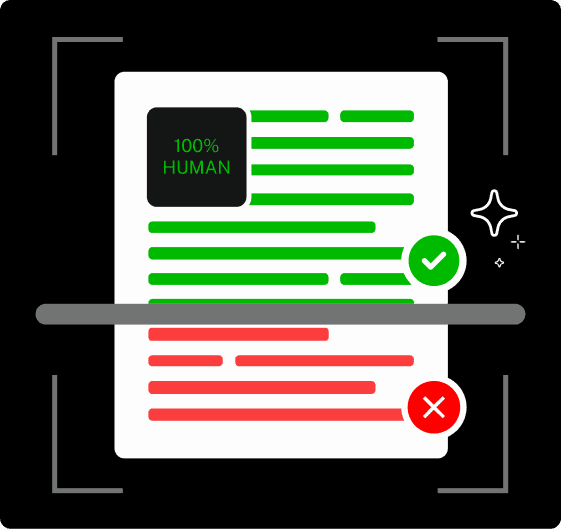

Never Worry About AI Detecting Your Texts Again. Undetectable AI Can Help You:
- Make your AI assisted writing appear human-like.
- Bypass all major AI detection tools with just one click.
- Use AI safely and confidently in school and work.
Research papers, literary analyses, and philosophical essays often require a more in-depth exploration of each point.
Jon Ziomek, associate professor at the Medill School of Journalism, says, “Long paragraphs are a visual predictor that a story won’t work.” Well, is this true?
For digital readers and newsroom editors, probably. But when it comes to deeply reasoned academic or literary work, brevity isn’t always the best metric for effectiveness.
Paragraphs tend to be shorter in business and professional writing, often between 40 and 100 words.
Emails, reports, booklets, and memos prioritize clarity and readability, as professionals don’t have time to wade through dense blocks of text.
If we look at a single edition of The Times (excluding the sports section), here’s what it looks like if word per paragraph was analyzed:
- Ranged from 9.6 to 67.5 words long
- Averaged 36 words per paragraph
- Had a median length of 37 words
Digital content takes brevity even further. Blog posts, website copy, and social media content frequently use paragraphs of 20 to 60 words.
The constraints of screen reading and the demands of online attention spans favor these shorter chunks.
A wall of text on a webpage is the quickest way to lose your audience.
Creative writing exhibits the greatest variability. Fiction writers might use single-word paragraphs for dramatic effect or stretch to several hundred words to build atmosphere.
Poetry breaks all conventional paragraph rules, creating its own visual and rhythmic structures.
Journalism has traditionally employed the inverted pyramid approach, with paragraphs getting progressively shorter as the article continues.
News articles typically start with paragraphs of 40 to 50 words and taper down to 20 to 30 words.
With these ranges in mind, we might say that the “average” paragraph across all types of writing contains roughly 75 to 125 words. But remember, these are just guidelines, not rules cast in stone.
So, How Many Words Is 3 Paragraphs?

Based on our understanding of average paragraph lengths, three paragraphs could range anywhere from 60 words (if you’re writing very short, digital-friendly paragraphs) to 600 words (if you’re crafting lengthy academic paragraphs).
But let’s break this down more specifically:
For academic writing or essay writing, three paragraphs typically total 300 to 600 words.
This gives you enough space to introduce a concept, develop it with evidence, and connect it to your broader argument.
A three-paragraph structure works well for brief response papers or as sections within longer academic works.
In business writing, three paragraphs usually run between 120 and 300 words. This compact format works perfectly for short memos, introductory emails, or executive summaries.
You can present your main point, provide supporting details, and end with a call to action or conclusion.
For digital content, three paragraphs might contain just 60 to 180 words.
Even with this limited word count, you can craft an effective introduction, make your key point, and close with a memorable takeaway or question.
Social media posts, short blog introductions, and product descriptions often follow this structure.
In creative writing, three paragraphs could be anything from a few dozen words to several hundred.
A flash fiction piece might tell an entire story in three short paragraphs, while three paragraphs in a novel might describe a single moment in exquisite detail.
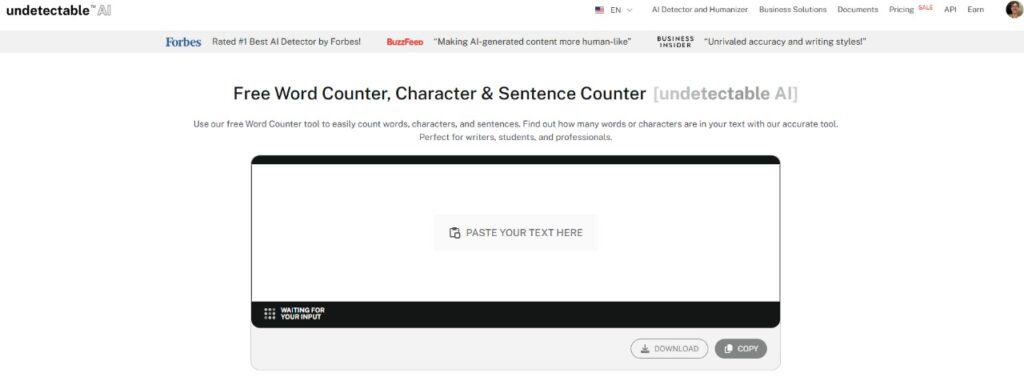
Need to quickly count how many words you’ve written?
Undetectable AI’s Word Counter provides an instant, accurate count of words, characters, and sentences.
This free tool helps you stay on track with assignment requirements or content guidelines without the hassle of manual counting.
Tips for Writing Strong 3-Paragraph Pieces
The three-paragraph format is deceptively challenging. With limited space, every word must pull its weight.
Here’s how to make your three paragraphs work:
- Start with structure. Give each paragraph a clear role. In its simplest form, think introduction, body, and conclusion. Your first paragraph presents your main idea, the second develops it, and the third wraps things up. This classic structure works across most writing contexts.
- Focus on a single main idea. Three paragraphs don’t give you room to explore multiple complex concepts. Choose one clear point and stick to it. If you find yourself straying into new territory, you might need more paragraphs or a tighter focus.
- Hook readers immediately. With just three paragraphs, you don’t have the luxury of a slow buildup. Your first sentence should be attention-grabbing and clearly signal what’s to come. Consider starting with a provocative question, a surprising statistic, or a vivid image.
- Use the middle paragraph wisely. This is where you develop your main point. Depending on your purpose, this might mean providing evidence, explaining a process, or exploring implications. Make every sentence count toward strengthening your central idea.
- End with purpose. Your final paragraph should do more than simply restate your point. It should elevate the discussion by explaining why your idea matters, suggesting next steps, or leaving readers with something to consider. A three-paragraph piece needs a strong landing.
- Revise ruthlessly. When working with just three paragraphs, clarity and concision become even more critical. Cut unnecessary crutch words, eliminate tangents, and ensure each sentence advances your purpose. Ask yourself: “If I had to remove one sentence from each paragraph, which would go?” Then consider whether those sentences are truly needed.
- Match your tone to your medium. A three-paragraph email to a colleague will differ dramatically from a three-paragraph literary analysis. Pay attention to vocabulary, sentence complexity, and formality based on where and why you’re writing.
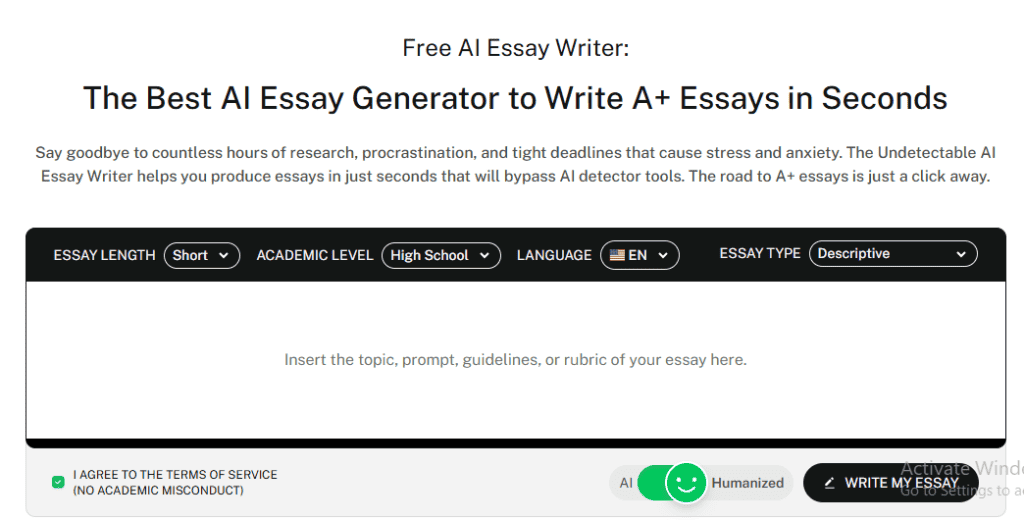
Undetectable AI’s Essay Writer can help those struggling to craft compelling three-paragraph pieces.
This AI-powered tool helps generate well-structured content that maintains a natural, human writing style.
Whether you need a starting point or help refining your ideas, it provides intelligent assistance without the telltale markers of machine-generated text.
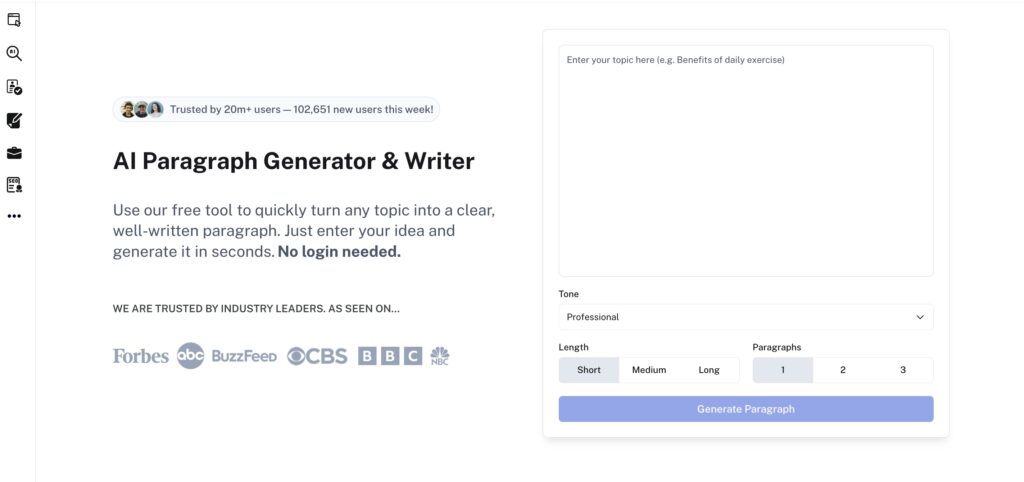
You can also try Undetectable AI’s AI Paragraph Generator and Writer to quickly build paragraphs that match specific word counts and flow naturally.
It’s great for structuring your three-paragraph pieces with the right balance of clarity and rhythm while keeping your tone consistent and authentic.
How Many Paragraphs is…
Understanding how word counts translate into paragraphs helps you plan your writing and manage expectations, especially when working under specific formatting or submission rules.
But rather than guess, we created two different versions of a 250-word sample: one written in a dense, academic tone and another in a more casual, blog-style format, paying more attention to style and tone than paragraph length.
Then, we ran it through the Undetectable AI Word Counter. The results?
- The essay-style version clocked in at 2 paragraphs.
- The casual version broke naturally into 5 paragraphs.
Same word count, different structure—and a big difference in how it reads.

Image: Version A: Essay Style (Dense) — 250 words, ~2 paragraphs
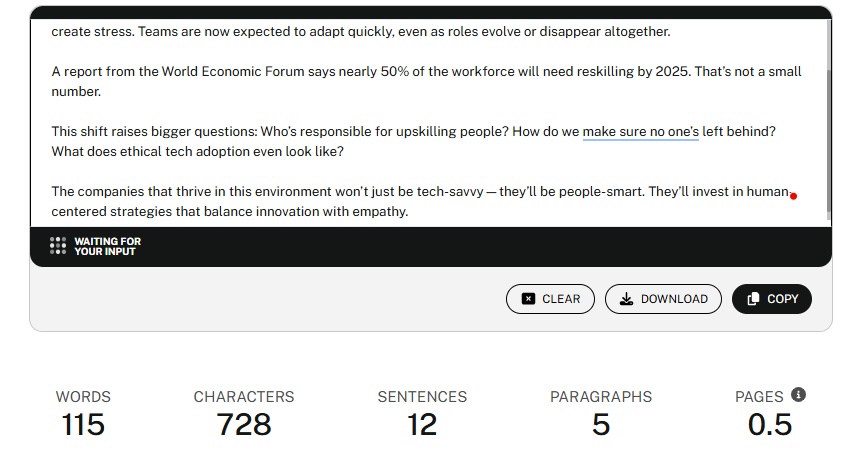
Image: Version B: Easy Writing (Casual) — 250 words, ~5 short paragraphs
With that in mind, here’s a practical breakdown of how many paragraphs you can expect based on your word count and writing style:
- 250 words is 1 to 3 paragraphs for essays, 3 to 5 paragraphs for casual writing: Works well for short discussion posts, extended social media content, or brief product descriptions.
- 500 words is 3 to 5 paragraphs for essays, 5 to 10 paragraphs for casual writing: This common length suits blog posts, short articles, or one-page reports. It gives you enough space to develop a single idea thoroughly.
- 750 words is 4 to 8 paragraphs for essays, 8 to 15 paragraphs for casual writing: Many standardized essay assignments fall in this range. It allows for an introduction, several supporting points, and a conclusion.
- 1000 words is 5 to 10 paragraphs for essays, 10 to 20 paragraphs for casual writing: Supports more complex arguments or explanations, making it suitable for in-depth blog posts, substantial articles, or short academic papers.
- 1500 words is 8 to 15 paragraphs for essays, 15 to 30 paragraphs for casual writing: At this length, you can explore multiple facets of a topic or provide detailed analysis of a complex subject.
- 2000 words is 10 to 20 paragraphs for essays, 20 to 40 paragraphs for casual writing: Here, you’re allowed a comprehensive treatment of your subject with multiple supporting points and examples.
- 2500 words is 13 to 25 paragraphs for essays, 25 to 50 paragraphs for casual writing: Research papers, in-depth analyses, and comprehensive guides often fall within this range.
- 3000 words is 15 to 30 paragraphs for essays, 30 to 60 paragraphs for casual writing: This length supports exploration of complex topics with nuance and substantial evidence.
- 4000 words is 20 to 40 paragraphs for essays, 40 to 80 paragraphs for casual writing: Now you’re approaching the territory of academic journal articles or chapters.
- 5000 words is 25 to 50 paragraphs for essays, 50 to 100 paragraphs for casual writing: This substantial word count allows for thorough investigation of complex topics with multiple facets.
These estimates vary based on your writing style, complexity of ideas, and formatting choices.
Undetectable AI’s Word Counter can help you track your progress as you write, showing exactly how your current word count translates to paragraphs in your particular writing style.
See how our AI Detector and Humanizer work—find them in the widget below!
FAQ
How many paragraphs is 1,000 words?
Typically 5–10 paragraphs for essays and formal writing, and 10–20 for online content with shorter blocks.
It depends on your writing style and audience.
How many paragraphs are in an essay?
Short essays often follow the five-paragraph structure, but longer ones (like 1,500–2,000 words) may have 8–20 paragraphs.
Focus on clarity and purpose over a set number.
How many words are in a paragraph?
– Academic: 100–200 words
– Business: 40–100 words
– Online: 20–60 words
– Adjust based on clarity—too long loses readers, too short lacks depth.
Paragraphs with Purpose
Remember that paragraph length should serve your purpose, not constrain it. Academic writing may call for fuller development, digital content may demand brevity, and creative writing may play with convention.
The “right” number of words for three paragraphs depends entirely on what those paragraphs need to accomplish.
As you continue developing your writing skills, pay attention to how effective writers in your field structure their paragraphs.
Notice how they signal transitions, develop ideas, and maintain reader interest. Your own paragraphs will grow stronger through this conscious attention.
Tools like Undetectable AI’s Word Counter and Essay Writer can support your writing process, but the most important factor is your clarity of thought and purpose.
When each paragraph serves a clear function and flows naturally to the next, your three-paragraph piece (or any piece of writing) will connect with readers and convey your message effectively.
Master the paragraph, and you master the art of written communication itself.
